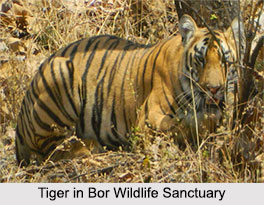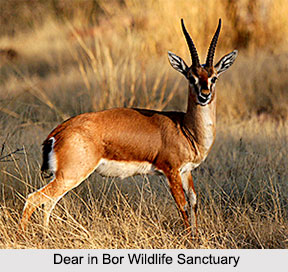 Bor Wildlife Sanctuary is located in the Indian state of Maharashtra. More specifically, this wildlife sanctuary is situated near Hingani in the district of Wardha. It is known to be centrally located among several other Bengal tiger habitats like the Pench Tiger Reserve (about 90 square kilometers to the northeast), Nagzira Navegaon Tiger Reserve (about 125 square kilometers (48 sq mi) to the east northeast), Umred Karhandla Wildlife Sanctuary (about 75 square kilometers (29 sq mi) to the east southeast), Tadoba - Andhari Tiger Reserve (about 85 square kilometers (33 sq mi) to the southeast), Melghat Tiger Reserve (about 140 square kilometers (54 sq mi) to the west northwest) and Satpura National Park and Tiger Reserve (about 160 square kilometers (62 sq mi) to the northwest). The managing body of this wildlife sanctuary is Maharashtra State Forest Department.
Bor Wildlife Sanctuary is located in the Indian state of Maharashtra. More specifically, this wildlife sanctuary is situated near Hingani in the district of Wardha. It is known to be centrally located among several other Bengal tiger habitats like the Pench Tiger Reserve (about 90 square kilometers to the northeast), Nagzira Navegaon Tiger Reserve (about 125 square kilometers (48 sq mi) to the east northeast), Umred Karhandla Wildlife Sanctuary (about 75 square kilometers (29 sq mi) to the east southeast), Tadoba - Andhari Tiger Reserve (about 85 square kilometers (33 sq mi) to the southeast), Melghat Tiger Reserve (about 140 square kilometers (54 sq mi) to the west northwest) and Satpura National Park and Tiger Reserve (about 160 square kilometers (62 sq mi) to the northwest). The managing body of this wildlife sanctuary is Maharashtra State Forest Department.
History of Bor Wildlife Sanctuary
Bor Wildlife Sanctuary has been recorded in the pages of history as an important place during the time of Mahabharata. This sanctuary was found to have the archaeological remains known as the Nasargarh and Gidamgarh, which are suggestive of the existence of a seat of power in the beginning of the 1st century. On 13th September 2010, the then Minister of Environment and Forests, Jairam Ramesh, announced the intention to establish a Bor Tiger Reserve. Bor Wildlife Sanctuary was notified as the 47th tiger reserve in India by the Environment Minister, Prakash Javadekar. This notification was made with the purpose to consolidate the conservation efforts of the national animal. On 7th July, 2014, this wildlife sanctuary was declared as the 47th tiger reserve of India.
Geography of Bor Wildlife Sanctuary
Globally, Bor Wildlife Sanctuary can be pinpointed at coordinates 20 degrees 58 minutes 39 seconds north and 78 degrees 40 minutes 33 seconds east. This wildlife sanctuary falls under the time zone, Indian Standard Time (Coordinated Universal Time (UTC) +5:30). It has an elevation of about 460 m (1,510 ft) above mean sea level. This wildlife sanctuary area experiences three seasons namely, summer, winter and the rainy season.
This sanctuary is spread over a total area of about 121.1 square kilometers (46.8 sq mi). According to a notification issued in April, 2012 by the Maharashtra State Government, an area of about 60 square kilometers (23 sq mi) would be added to the original 61.1 square kilometers (23.6 sq mi) area of the Bor Wildlife Sanctuary. This sanctuary was thus provided with a new Core Zone, Eco-tourism Zone and a Buffer Zone. The Core Zone is spread over an area of about 115.92 square kilometers (44.76 sq mi). This zone consists of about 95.7% of the total area of the sancturay. It is the most protected part of the sanctuary and public entry is prohibited is this protected region. Most of the core area shares a common border with the forest of Wardha Forest Division and Nagpur Forest Division. The Eco-tourism Zone is spread over an area of about 5.21 square kilometers (2.01 sq mi). This zone consists of about 4.3% of the total area of the sanctuary. Public entry is permitted is this region for nature and wildlife tourism. The tourism zone aims to educate the public about the significance of nature and wildlife conservation and to stimulate their environmental awareness. The Buffer Zone is a relatively less protected forest area in the vicinity of the sanctuary. It acts as a protective barrier for the core area. The Bor Wildlife Sanctuary has been declared as a "satellite area" as it has the capability to act as an avenue for the tigers for disassembling from the source area of Pench.
Flora of Bor Wildlife Sanctuary
The eco zone of the Bor Wildlife Sanctuary or the South Deccan Plateau comprises of the dry deciduous forests. The main species of the above mentioned area are teak, tendu (East Indian ebony) and bamboo. This sanctuary is a home to main herbs like the tarot, tenella, tarwar, gokhru, wight (bracteata), vanbhendi, velatri and waghori.
Fauna of Bor Wildlife Sanctuary
Bor Wildlife Sanctuary is a home to mammal species like the Bengal tiger, Indian leopard, Indian bison, blue bull, chital, sambar deer, peacock, barking deer, mouse deer, monkey, wild boar, sloth bear and wild dog.
Bor Reservoir
The Bor Reservoir physically divides the Bor Tiger Reserve into 2 sections namely, the western part (40 square kilometers (15 square miles) and the eastern part (21 square kilometers (8.1 square miles). 95% of the western part is in Wardha district and 90% of the eastern part is in Nagpur district. The Bor Reservoir area is about 7.25 square kilometers (2.80 square miles) and is not included in the total sanctuary area.
Tourism of Bor Wildlife Sanctuary
On the outskirts of the Bor Wildlife Sanctuary, promotion of wildlife tourism was planned in the year 2002 for the Bhor Dam. The cost of this project was fixed at Rs 6.2 million. Bor Wildlife Sanctuary serves as a tourism product for Maharashtra due to several reasons. This wildlife sanctuary is a home to Buddhist temple (vihar) where buddhist teaching takes place. Other temples in the sanctuary are a Shiva temple at Khori-Khapa, Bruhaspati Temple at Chauki, Hanuman Temple at Khadki and Ganesh Temple at Kelzar.
Threats to Bor Wildlife Sanctuary
Certain uncontrolled and illegal activities are responsible for creating ecological crisis in the Bor Wildlife Sanctuary area. The quality of the sanctuary is being deteriorated by forest fires. In the year 2011, about 800 ha (3.1 sq mi) of forest area was ruined by ground fire. Tendu collection was illegally being undertaken in the 5 km (3.1 mi) buffer area around the sanctuary. Tiger attacks have also been reported due to increasing numbers of tigers in the sanctuary. In January, 2011, three villagers were attacked outside the sanctuary. Since the attacks took place beyond the boundaries of the sanctuary, the villagers were not compensated. The tigers were also reported killing the cattles owned by the villagers. The villagers have therefore turned against the tigers of the sanctuary. It thus can be said that this sanctuary needed enhanced protection and habitat management, especially in the forest areas nearby. The tendu collection also needed to be banned completely.
Conservation of Bor Wildlife Sanctuary
Due to threats faced by the Bor Wildlife Sanctuary, its conservation became imperative to the survival of the wildlife preserved in the area. A major step taken towards conservation is a nature interpretation center and tourism complex. This complex is known to function under the authority of the Addl. Principal Chief Conservator of Forests-Wildlife-East, Nagpur circle. The wildlife conservation NGO (Non-Governmental Organization) called the Srushti Paryavaran Mandal in association with the Maharashtra Forest Department-Pench Tiger Reserve office is in charge of the various conservation projects in the Bor Sanctuary, since 2005. Such conservation projects include water conservation through building small check dams, habitat mapping and rehabilitation of orphaned tiger cubs.
Visiting information
The time period between April and May is generally considered to be the best time to plan a tour to Bor Wildlife Sanctuary. This sanctuary has good transport availability. The nearest airport to this sanctuary is Dr. Babasaheb Ambedkar International Airport in Nagpur. This airport is located at a distance of about 80 km (50 mi) from the sanctuary. The nearest railway station to Bor Wildlife is in Wardha, which is located at a distance of about 35 km (22 mi) from the sanctuary. Hingni is the nearest bus station to Bor Wildlife. This bus station is located at a distance of about 5 km (3.1 mi) from the sanctuary. While journeying on the Wardha-Nagpur road MSH3 to reach Hingi, one would have to turn north at Seloo tehsil and then to the visitor center at Bor Dam.
Related Articles:
Indian Wildlife Sanctuaries
Indian National Parks
Indian Flora and Fauna
Indian Wildlife
Bird Sanctuaries in India
Indian Biosphere Reserves











